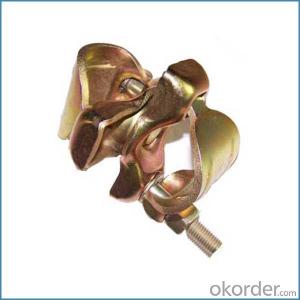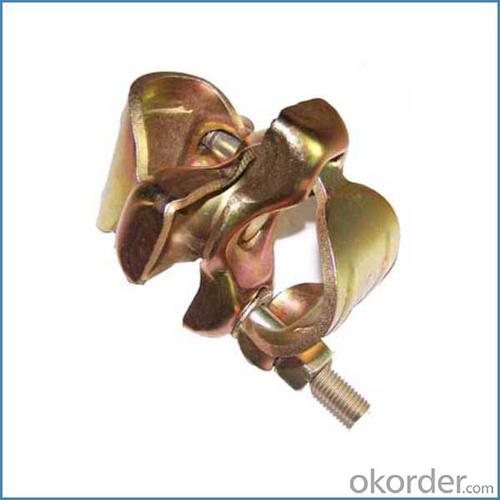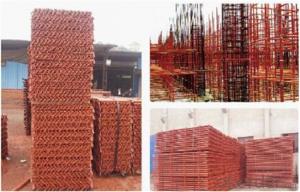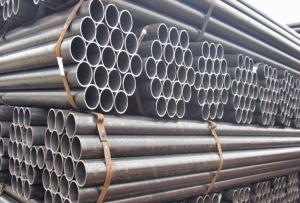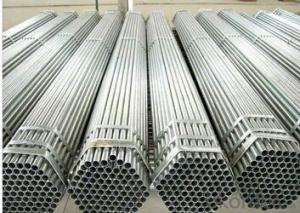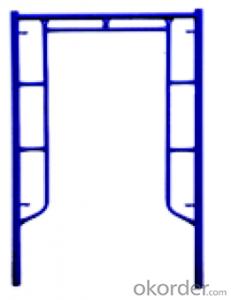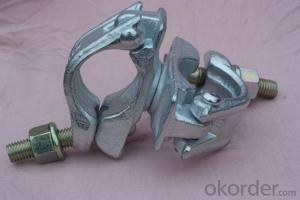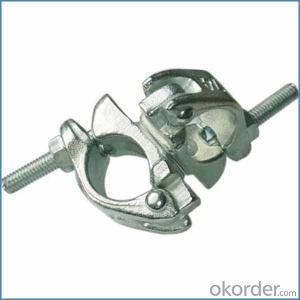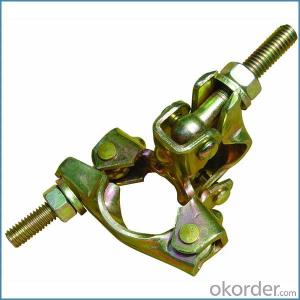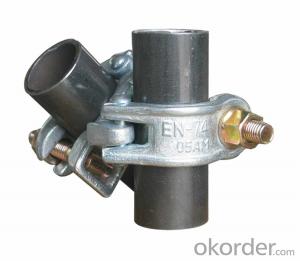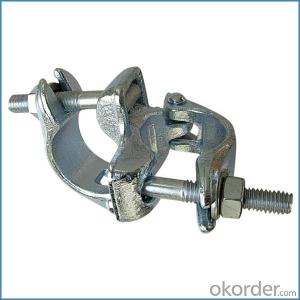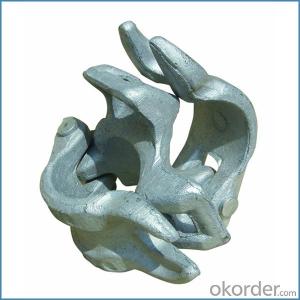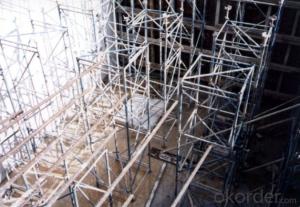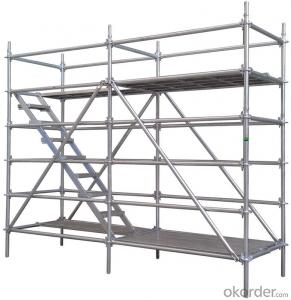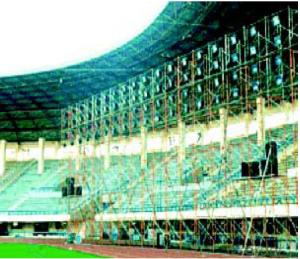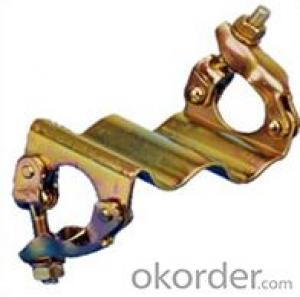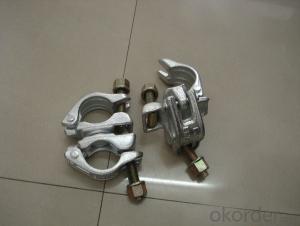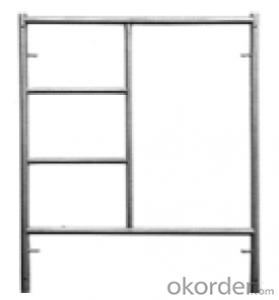Scaffolding Pipe Clamp british German Forged Type
- Loading Port:
- Tianjin
- Payment Terms:
- TT OR LC
- Min Order Qty:
- 1000 kg
- Supply Capability:
- 100000 kg/month
OKorder Service Pledge
OKorder Financial Service
You Might Also Like
Scaffolding Pipe Clamp british German Forged Type
Description
1.The scaffolding coupler is always used to connect the steel pipe as scaffolding system.
2.The often used coupler is swivel coupler and righ angle coupler .
3.We can provide types of scaffolding coupler according to your requirement.
4.Couoler can fix the 48.3mm scaffolding steel pipe tightly and make the whole scaffolding system more steadily.
Feature
(1)Excellent Anti-Breaking—Cold Pressed Steel
(2)Outstanding Resistance Deformation
(3)Strong Anti-Dropping Ability
Photo
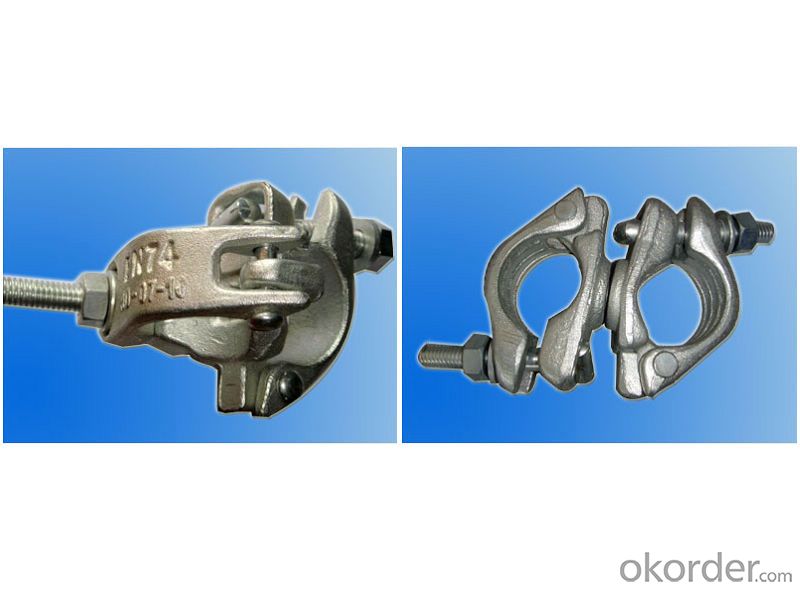
Parameter
| Material | Q235,345steel |
| Size | 48.3mm*48.3mm |
| Surface finish | Galvanized |
| Weight | 1.1kg around |
| Standard | BS1139,EN74 |
| Package | 25pcs/bag,steel pallet |
| Manufacture | As per customer requirement |
| Market | Africa, South America, the Middle East and Asia |
FAQ
Q: Are you a factory or trading company?
We are a state-owned corporation in China,dealing with various kinds of building materials.We have our holding subsidiaries.
Q: Where is your factory located? How can I visit there?
Our factory is located all around China.
Q: Can I get some samples?
Sample is free, customer only pay freight for the first time.
Q: Delivery?
10-30days. (5-15 containers)
Any question,feel free to contact us.
- Q: Can steel tube couplers be used for temporary or permanent scaffolding installations?
- Yes, steel tube couplers can be used for both temporary and permanent scaffolding installations. Steel tube couplers are designed to connect and secure scaffolding tubes, allowing for the construction of stable and reliable scaffolding structures. These couplers are typically made from high-quality steel, providing excellent strength and durability. For temporary scaffolding installations, steel tube couplers are often used due to their ease of assembly and disassembly. They can be quickly and securely attached to scaffolding tubes, enabling the construction of temporary platforms, walkways, and support structures. Once the temporary scaffolding is no longer needed, the couplers can be easily removed and reused for future projects. Similarly, steel tube couplers are also suitable for permanent scaffolding installations. They provide a robust and long-lasting connection between scaffolding tubes, ensuring the stability and safety of the structure. Permanent scaffolding installations, such as those found in construction sites or industrial facilities, require reliable and durable connections, making steel tube couplers an ideal choice. It is important to note that when using steel tube couplers for scaffolding installations, proper installation techniques and adherence to safety regulations should always be followed. Regular inspections and maintenance are also necessary to ensure the integrity and reliability of the scaffolding structure, regardless of whether it is temporary or permanent.
- Q: Are there any specific guidelines for the safe use of steel tube couplers in scaffolding near live electrical equipment or circuits?
- Yes, there are specific guidelines for the safe use of steel tube couplers in scaffolding near live electrical equipment or circuits. The guidelines typically recommend maintaining a safe distance between the scaffolding and the electrical equipment to prevent any accidental contact. Additionally, using non-conductive materials for scaffolding components near live electrical circuits is often advised to minimize the risk of electrical shock or accidents. Regular inspections, grounding, and proper training for workers are also important aspects of ensuring the safe use of steel tube couplers in such scenarios.
- Q: What is the typical lifespan of steel tube couplers in scaffolding applications?
- The typical lifespan of steel tube couplers in scaffolding applications can vary depending on several factors. The quality of the couplers, the frequency and intensity of use, and the maintenance and care provided can all affect their lifespan. Generally, high-quality steel tube couplers can last for several years when used in standard scaffolding applications. With regular inspections, maintenance, and proper care, they can withstand the rigors of construction sites and provide reliable support for extended periods. However, it is important to note that certain factors can reduce the lifespan of steel tube couplers. Exposure to harsh environmental conditions, such as extreme temperatures, moisture, and corrosive substances, can accelerate the deterioration process. Additionally, if the couplers are subjected to excessive loads or misuse, their lifespan may be significantly shortened. To ensure the longevity of steel tube couplers, it is crucial to follow manufacturer guidelines regarding their usage, storage, and maintenance. Regular inspections should be conducted to identify any signs of wear, damage, or corrosion. If any issues are detected, immediate repairs or replacements should be made to maintain the safety and integrity of the scaffolding system. Ultimately, while there is no fixed lifespan for steel tube couplers in scaffolding applications, their durability and longevity can be maximized through proper care, maintenance, and adherence to safety guidelines.
- Q: Can steel tube couplers be used with both horizontal and vertical scaffolding tubes?
- Steel tube couplers are versatile and can be used with both horizontal and vertical scaffolding tubes. Their purpose is to connect and secure scaffolding tubes in different configurations, including both horizontal and vertical orientations. These couplers have a firm hold and guarantee a dependable connection between the tubes, ensuring stability and safety in scaffolding structures. Whether you're building a horizontal platform or putting up a vertical tower, steel tube couplers are the perfect solution for creating a secure and robust scaffolding system.
- Q: Are there any specific guidelines for the safe use of steel tube couplers in scaffolding near high-pressure or pressurized systems?
- Yes, there are specific guidelines for the safe use of steel tube couplers in scaffolding near high-pressure or pressurized systems. 1. Risk Assessment: Before starting any work near high-pressure or pressurized systems, a thorough risk assessment should be conducted to identify potential hazards and determine appropriate control measures. This assessment should consider the proximity of the scaffolding to the system, potential impact forces, and the structural integrity of the scaffolding. 2. Competent Personnel: Only competent and trained personnel should be involved in the assembly, disassembly, and use of scaffolding near high-pressure or pressurized systems. They should have a good understanding of the risks involved and be familiar with the specific guidelines and safety procedures. 3. Structural Integrity: The scaffolding structure should be designed, erected, and inspected by competent individuals to ensure its stability and strength. The use of steel tube couplers in scaffolding near high-pressure or pressurized systems should comply with relevant standards and regulations to guarantee the structural integrity of the scaffolding. 4. Clearance: Sufficient clearance should be maintained between the scaffolding and the high-pressure or pressurized systems. This clearance will vary depending on the specific system, but it is crucial to prevent accidental contact or damage to the scaffolding caused by pressure release or burst. 5. Protective Measures: Additional protective measures may be required to mitigate the risks associated with high-pressure or pressurized systems. These may include the installation of barriers, warning signs, or protective shields to safeguard the scaffolding and workers from potential hazards. 6. Communication: Effective communication should be established between the personnel working on the scaffolding and those operating or maintaining the high-pressure or pressurized systems. This ensures that everyone is aware of the potential risks and can take appropriate precautions to prevent accidents. 7. Regular Inspections: Regular inspections of the scaffolding and its components, including steel tube couplers, should be conducted to identify any signs of deterioration or damage. Any issues should be promptly addressed, and damaged components should be replaced to maintain the safety of the scaffolding near high-pressure or pressurized systems. Overall, it is essential to follow these guidelines and any other specific recommendations provided by manufacturers, industry standards, or regulatory bodies to ensure the safe use of steel tube couplers in scaffolding near high-pressure or pressurized systems.
- Q: Are there any specific training or certification requirements for using steel tube couplers?
- Steel tube couplers necessitate specific training and certification. In numerous sectors, including construction, scaffolding, and engineering, individuals handling steel tube couplers must complete specialized training and acquire relevant certifications. These training programs generally encompass topics such as the correct installation and inspection of couplers, comprehension of load capacities, and adherence to safety protocols. Certification is typically obtained through reputable industry organizations or regulatory bodies, serving as evidence that an individual possesses the requisite knowledge and abilities to use steel tube couplers safely and effectively. Adhering to these requirements is crucial to guarantee the structural integrity and safety of any project involving steel tube couplers.
- Q: Can steel tube couplers be used for scaffolding projects with complex load transfer mechanisms?
- Yes, steel tube couplers can be used for scaffolding projects with complex load transfer mechanisms. Steel tube couplers are designed to securely connect scaffold tubes, providing a reliable and strong connection. Their versatility allows for the construction of complex scaffolding structures that can handle various load transfer mechanisms, ensuring safety and stability in the project.
- Q: What is the typical lifespan of steel tube couplers in scaffolding applications?
- The typical lifespan of steel tube couplers in scaffolding applications can vary depending on various factors such as usage, maintenance, and environmental conditions. However, when properly used and maintained, steel tube couplers can often last for several years or even decades without significant deterioration.
- Q: Are there any specific regulations or guidelines for the disposal of steel tube couplers?
- Yes, there are specific regulations and guidelines for the disposal of steel tube couplers. The exact regulations may vary depending on the country or region, but in general, the disposal of steel tube couplers should be done in an environmentally responsible manner. One common guideline is to separate the steel tube couplers from other waste materials and ensure they are properly stored before disposal. This may involve placing them in designated containers or bins specifically meant for metal recycling or disposal. It is also important to consider the potential hazards associated with steel tube couplers. If they have been used in conjunction with hazardous substances or materials, additional precautions may be necessary. In such cases, it is advisable to consult local regulations or seek guidance from the appropriate authorities to ensure compliance with specific disposal requirements. In conclusion, it is essential to adhere to the applicable regulations and guidelines for the disposal of steel tube couplers to protect the environment and ensure the safety of individuals involved in the disposal process.
- Q: Can steel tube couplers be used for both internal and external scaffolding structures?
- Steel tube couplers are suitable for both internal and external scaffolding structures. They are versatile and durable, making them appropriate for various scaffolding applications. These couplers are commonly utilized to securely and rigidly connect and join steel tubes together. Whether for internal or external scaffolding structures, steel tube couplers provide the necessary strength and stability for safe and efficient construction work. Moreover, they are designed to withstand diverse weather conditions and environmental factors, making them suitable for indoor and outdoor use. In summary, steel tube couplers are a dependable and efficient solution for scaffolding structures, regardless of the specific application.
Send your message to us
Scaffolding Pipe Clamp british German Forged Type
- Loading Port:
- Tianjin
- Payment Terms:
- TT OR LC
- Min Order Qty:
- 1000 kg
- Supply Capability:
- 100000 kg/month
OKorder Service Pledge
OKorder Financial Service
Similar products
Hot products
Hot Searches
Related keywords
